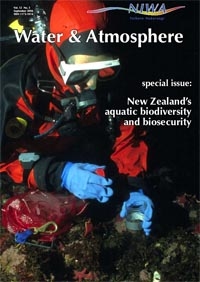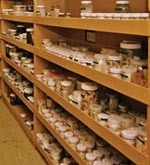PDF of this article (98 KB)

Anne-Nina Lörz Niel Bruce
NIWA holds a major collection of marine invertebrates from beyond the intertidal zone for the world’s fifth-largest EEZ.

For many marine invertebrate groups, the southwestern Pacific has the world’s highest species diversity. This is related to the variable seafloor relief and, also in the case of New Zealand, an ancient geological history.
The NIWA Marine Invertebrate Collection (NIC) holds specimens from almost all invertebrate phyla, plus unsorted and residue samples, collected over five decades of research in the New Zealand region, the southwestern Pacific and the Ross Sea. Such specimens are part of New Zealand’s national cultural heritage, and essential for our knowledge of biodiversity as reference specimens for all future marine invertebrate taxonomic research. With partial funding from the Foundation for Research, Science and Technology, NIC is designated as a Nationally Significant Collection.
Why keep biodiversity collections?
The character of the New Zealand land and sea is determined by its biological components. The first steps in understanding this are to discover what is there. When combined with a knowledge of species biology we can better plan to conserve and sustainably use these natural resources.
The collection is analysed and reported in international publications and NIWA’s Biodiversity Memoirs. Since the first volume in 1955 (under the aegis of the New Zealand Oceanographic Institute), 79 monographs have been published, yet many diverse and significant groups remain unstudied. The Memoirs are highly regarded by national and international biologists. They are a critical resource for those involved in conservation, environmental inventory, resource and biodiversity management, and popularising New Zealand and Antarctic natural history.
Human health, aquaculture, fisheries, marine reserves, and biosecurity all benefit from the knowledge provided by marine taxonomy and underpinned by NIC.
Marine organisms are sources of significant biochemicals.
Sponges, bryozoans, sea squirts, and other organisms produce biochemicals that are cytotoxic, anti-cancer, antibiotic, antiviral, biocidal, or useful in cosmetics. Accurate taxonomy supported by the NIC is crucial in natural products research.
NIC assists ecological research.
Ecological survey data can rapidly become useless if voucher specimens are not held for later comparison. Species lists cannot be confirmed without the specimens.
NIC improves biosecurity.
There are two lines of defence in biosecurity: prevention and early recognition, which may allow for successful eradication or control measures. Collections of known indigenous fauna are essential to allow us to determine if a particular animal is a native or alien species.
NIC informs marine conservation.
The identity, distribution, and abundance of most marine invertebrate species are poorly known. Knowing what is indigenous, widespread, unique, rare, or threatened is essential in identifying areas of seafloor for marine reserves or assessing threatened-species status.
NIC is a treasure chest for scientific studies.
New Zealand has a large number of species, genera, and even some families and orders that are endemic, that is, found nowhere else in the world. Some species have distinctive attributes (like archaism – “living fossils”), special habitat associations, or special ecological roles.
Hundreds of species are still being identified from the growing collection. For example, eight new species of bubble-gum corals in NIC were described last year. These “kauri” of the seafloor are the largest benthic (seafloor) organism and some of the corals dated to 500 years old.
Significant beyond our shores
NIC is of national and international significance because it is essential for determining the evolutionary and biological relationships of the New Zealand marine biota in relation to the rest of the world. It provides data to international scientists for global bioinformatic activities like Species 2000. In the face of changing technologies and concepts, it is the specimens that provide grounds for hypothesis testing.
Anne-Nina Lörz and Niel Bruce are based at NIWA in Wellington. Anne-Nina is the collection manager of the NIWA Marine Invertebrate Collection.
